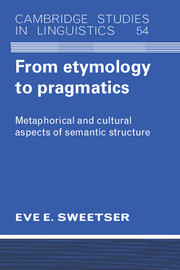Book contents
4 - Conjunction, coordination, and subordination
Published online by Cambridge University Press: 05 June 2012
Summary
While modality may offer self-evident cases of polysemy (between the root and epistemic senses), there are other areas of the lexicon where few would even suggest that differences in usage correspond to a polysemy between linguistic domains. The purpose of this chapter is to show that conjunctions, like modal verbs, are “ambiguous” among usages in the content, epistemic, and conversational domains. A simple analysis of conjunctions as logical operators will prove far too weak to explain the ambiguities in their usage, or to account for the fact that ambiguities between domains are to be observed equally in simple conjunction (and disjunction) and complex lexical conjunctions such as therefore or although. Not only must conjunctions be given a more complex lexical-semantic analysis, but their contribution to sentence semantics must be analyzed in the context of an utterance's polyfunctional status as a bearer of content, as a logical entity, and as the instrument of a speech act.
I will give arguments suggesting that (at least for some conjunctions) a lexical-polysemy analysis is implausible, and that instead these conjunctions are examples of what Horn (1985) has called pragmatic ambiguity. In polysemy, a morpheme has several related semantic values; in pragmatic ambiguity (see chapter 1), a single semantics is pragmatically applied in different ways according to pragmatic context. It is interesting to observe that our three-way understanding of utterances as content, epistemic entity, and speech act is relevant to this pragmatic-ambiguity structure, as well as to the polysemy structure of lexical items such as the modals.
- Type
- Chapter
- Information
- From Etymology to PragmaticsMetaphorical and Cultural Aspects of Semantic Structure, pp. 76 - 112Publisher: Cambridge University PressPrint publication year: 1990



